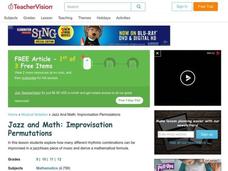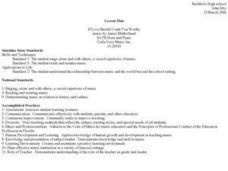Curated OER
VH1 Driven: Jamie Foxx, Lesson 2
Students compare and contrast classical piano style with jazz piano style. They watch a segment of the video, "VH1 Driven: Jamie Foxx," participate in a class discussion of the music from the video, and develop a list of adjectives for...
Curated OER
2 Black Keys, 3 Black Keys
Students explore the black keys on the piano and basic music theory techniques using the Internet as a guide. Websites visited include www.PianoNanny.com and musictheory.net.
Curated OER
Jazz and Math: Improvisation Permutations
Students observe that there are myriad combinations of rhythms to choose from when improvising jazz and blues music, and recognize that while the variations seem infinite, they are in fact finite. They notate a 12 bar blues progression...
Curated OER
Which Instrument is Your Favorite To Listen To?: Graph
In this favorite instrument bar graph worksheet, students will ask their classmates which is their favorite to listen to: drums, guitar, flute, piano, saxophone, or trumpet? Then students will record the responses to complete the graph.
Curated OER
Pitch-er Perfect
Learners investigate music and what causes the pitch of a sound. For this sound properties lesson, students listen to a story about animals and the instinctual pitch they have in their voice and how musicians have that as well....
Curated OER
The Fibonacci Keyboard- Jazz and Math
Pupils demonstrate an understanding of the relationships of the Fibonacci Sequence. They apply the Fibonacci Sequence and find its relationship to a piano keyboard. They explore various relationships between music and the Fibonacci...
Curated OER
Dynamics
First graders review Frere Jacques and perform crescendos and decrescendos. In this music lesson plan, 1st graders also learn about the dynamics of music including piano, forte, mezzo piano, and mezzo forte.
Curated OER
Lesson Plan for Danse by Claude Debussy
Students study the life and music of Claude Debussy. They listen to and compare the orchestration and compositional technique of the Debussy composition, 'Danse.' They compare a piano arrangement to an orchestrated version.
Curated OER
Music Technology
Students use their practice book to complete their piano lessons. They examine the history of music and complete pages in a workbook. They create their own music by using the computer.
Curated OER
Music Technology Programs
Students are introduced to the music technology programs for the next school year. They practice reading notes and playing piano. They use the internet to research careers in music.
Curated OER
The Classical Period
Sixth graders are introduced to the classical period in music history. After listening to examples, they identify and describe the characteristics of music during this time period and research the main composers. Using the internet,...
Curated OER
If Love Should Count You Worthy
Students sing "If Love Should Count You Worthy" by James Mulholland for SATB choir, horn, and piano and a version of "The Drinkin' Gourd" in this High School choir lesson. State and National standards for Music are emphasized.
Curated OER
Tap Dancing Word Search
For this Tap Dancing Word Search worksheet, learners find 14 words related to tap dancing. An example of the words include lessons, piano, and tuxedo.
Curated OER
Intermediate Practical Writing- "Invitation"
In this writing worksheet, students read the example of a note of invitation. Students use the blank lines to write a note to friends inviting them to a piano recital.
Fun Music Company
Intervals
As part of their study of intervals, musicians are asked to draw the interval indicated above the notes provided on the worksheet.
Fun Music Company
Transposition
Up a perfect fifth, down an octave. Transposing a piece to suit the range of singers, and instrumentalists, is a key skill musicians must perfect. This worksheet explains how to transpose and gives learners a change to practice.
Fun Music Company
Working Out the Key
"Gimme an E minor!" Or any key for that matter. But how do you figure out the key of a piece of music? Here's a worksheet that shows young musicians three easy steps to help them identify the key of a piece of music.
Fun Music Company
The Harmonic Minor Scale
The harmonic minor scale, including the use of accidentals, is the focus of a one-page worksheet that includes instructional information and practice exercises.
Fun Music Company
Classification of Intervals
Major 2nd, Perfect 4th, Minor 3rd. The number and classification of intervals are the focus of a one-page worksheet that asks musicians to write the intervals above given notes and to indicate the classification of others.
Fun Music Company
Relative Major and Minor
It's all relative. Young music theorists are asked to count to three and identify the relative major and minor keys of keys that share the same signature.
Fun Music Company
Treasure Island Clues
In order to answer a music trivia question, young musicians must count the number of ties in a melody, name the final note, and use these clues to spell out Charlie Parker's nickname. This activity is not for the birds.
It's About Time
Sounds in Strings
How many of your pupils play an instrument? A musical science lesson will help all of them understand how string instruments work. Young scientists construct a string-and-pulley system to test frequency and pitch. The lesson ends with a...
Berklee College of Music
Create Your Own Afro-Latin Groove
The backbone of Latin American music is the beat! Young musicians work on blending Afro-Latin rhythms and beat patterns before incorporating the major pentatonic, minor pentatonic, and blues scales in their own compositions.
Curated OER
Say It Loud!: A Celebration Of Black Music In America - Gospel Beginnings
High schoolers identify musical characteristics of gospel and sing a gospel selection. They practice the call and response technique. After going through individual parts, they sing the entire song with piano accompaniment.
Other popular searches
- Group Piano
- Piano Keyboard
- Classical Music Piano
- Piano Lessons
- Beginning Piano
- Piano and Forte
- Piano Teaching
- Piano Lessons Plans
- Music Piano
- Thumb Piano
- Jazz Piano Style
- How to Play Piano

























